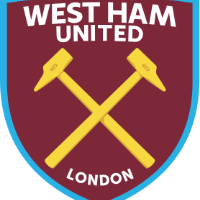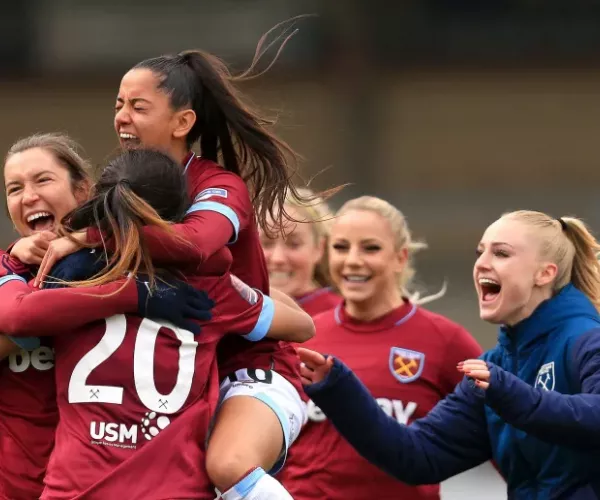
West Ham United Women

1990 London
There-was a short lived team called West Ham United Ladies in the early 1970s, but it was in 1991 when the club founded the Women’s side (originally Ladies) that transitioned into the one we know today.
Early life
Coached by John Greenancre, the Irons’ first game was on the 29th March 1992, a friendly with local side Barnet Ladies which resulted in defeat. They then went on to enter two teams into the Greater London Regional Women's Football League for the following season, in the third and fourth division retrospectively. The better of the two went on to finish in a strong fourth place, although the other suffered relegation to the fifth tier. Consecutive third place finishes in their next two seasons saw them reach the top flight for the 95/96 season.
That year did not see the same heights of the past two, and saw a mid-table finish that kept them in their league. They enteres their first Women’s FA Cup, and also saw Claire Lacey - their goalkeeper, become their first international representative when she played an away game at Portugal for the Lionesses. The hammers ended the decade strongly, an upturn in form saw them reach the final of the Russell Cup in 98/99, finishing just behind a semi-professional Fulham. They then reached the fourth round of the FA Cup the year after and won their first league title.
The 2000s
At the turn of the millennium, the club created their first junior side which competed in the Essex County Girls League, this inception helped to lay foundations which would ensure the club’s future, with a now clear pathway to develop talent who could go through to play for the first team when needed.
A second period of growth saw the club saw them reach the promotion playoff final from their league which enabled football in the South East Combination League in the 2002-03 campaign. The Irons eventually reached the FA Women’s Premier League (now National League South), when they defeated Northampton in a winner-takes-all final in the 04/05 season. West Ham became settled in the division, and found thier footing in the women’s football pyramid.
Whilst the main side stayed stagnant, the success was to be seen with the rising junior side. In the remainder of the decade, it was victorious in the London FA Girls Youth Cup, Southern Region Under 16 FA Tesco Cup, and the UK Tesco Cup which was played at the Reebok Stadium, home to then Premier League Bolton Wanderers.
Before the WSL
In the summer of 2014, former professional player Julian Dicks took charge of the then Ladies team. He had a strong first season, and helped to guide them from tenth place up to sixth in their division. Even more progression happened the year later, when John Hunt and his son Stephen were appointed as joint Chairmen of the club.
Dicks’ performances resulted in him being promoted within the Irons’ ranks to work with the men’s first team, and was replaced by Marc Nurse. They tracked back to a tenth place finish in the 2015/16 season, although it was a season marred with controversy. At the start of the season, club captain Stacey Little led a walkout of players and went to local press, criticising the club for their lack of funding. The Ladies side also featured in a match at Upton Park in the club’s last season there before their move to the Olympic Stadium, in front of a record crowd of 1741, playing out a 1-0 victory against Tottenham Hotspur. The game earned fame for when a video of a Spurs defender stamping on the head of Irons attacker Whitney Locke went viral on the internet.
During the summer of 2016, losses against MSV Duisberg and FC Twente resulted in the replacement of Nurse by James Marrs who had led Brighton to promotion but was then sacked in a decision that was plauged with its controversial circumstances. Marrs was aqcuited and has his record cleared after an appeal with the FA. The day after this, West Ham United released Marrs and the Hunts were replaced as chairmen with the Ladies absorbed into the main club. Stephen Hunt had lodged a complaint with the FA over his side’s treatment by the men’s establishment, and the unfavourable coverage from the press by on this situation was what many feel triggered the takeover of the Ladies team. The West Ham Foundation guided the team for the rest of the campaign.
In their final season before their move to become professional, a number of significant changes were made in the management of the club. Jack Sullivan was named as chairman, with Karen Ray general manager. Greg de Carnys moved from the men’s academy to look after the ladies’ team and academy, and the first half of the season coincided with poor results with 12 losses in only 17 games. De Carnys parted company with the club in December with Ray then taking the reigns. The results then took a turn for the better, which led to the club being victorious in both the Isthmian League Women’s Cup and the FA WPL Plate.
Present day
Not only was the 2018-19 season a monumental one for the Irons, but the entirety of the English women’s game. The club, now headed up by Jack Sullivan, the youngest son of men’s side owner David at only 18 years old, were successful in joining the Women’s Super League for the first season that it would be all professional, and they changed their name to West Ham United Women in a progressive move that showed how the female side was now being treated more seriously by the entire club.
Training and playing in good facilities at Rush Green, former WSL-winning coach Matt Beard was appointed to be the person to steer the club forward in their top season in England’s highest division. Beard secured experienced signings in Gilly Flaherty, Claire Rafferty, Jane Ross, and Tessel Middag in preporation for the 18/19 campaign, although the Norwegian suffered an injury to her ACL before she was able to take to the pitch and was sidelined for an entire season. One of the many that had been brought in was Alisha Lehmann, a promising young Swiss internaional who Beard had been impressed with when he saw her at the Under 19 European Championships, she became one of the Hammers’ standout players, scoring eight goals and netting against Reading in the FA Cup semi-final.
After a weak start to the season in which they suffered heavy losses including their highest ever WSL defeat, 7-1 away to Manchester City, they had an upturn in form and although they struggled throughout the year with many injuries, they coasted to a seventh place finish. However, it was in the cup that the squad really shone. West Ham had the luck of the draw on their side, and they faced lower league opposition in all rounds until the semi-final. In that game they played Reading, and after going one down in the 49th minute, Lehmann equalled the scoring eight minute later. The match went to penalties, and Cho So-Hyun took advantage of Jade Moore’s miss to seal them a place in the final. They fell 3-1 at Wembley to Manchester City, but it was a pivotal day for raising the profile of the Women’s side, with 43.264 flocking to the game and a number of them being Hammers. Their cup run was something that the men’s side had struggled to provide for a number of years, not yet playing a cup match at the new Wembley, their 2006 FA Cup Final at the Millenium Stadium in Cardiff.
Current Squad
1. Anna Moorhouse
2. Cecilie Kvamme
3. Erin Simon
4. Brooke Hendrix
5. Gilly Flaherty (Captain)
7. Alisha Lehmann
8. Lienne Kiernan
9. Martha Thomas
10. Julia Simic
11. Katherina Baunach
12. Kate Longhurst
15. Jacynta Galabadaarachchi
16. Ruesha Littlejohn
17. Esmee de Graaf
18. Courtney Brosnan
19. Adriana Leon
20. Cho So-hyun
21. Kenza Dali
23. Tessel Middag
24. Wiktoria Kiszkis
26. Laura Vetterlein








































